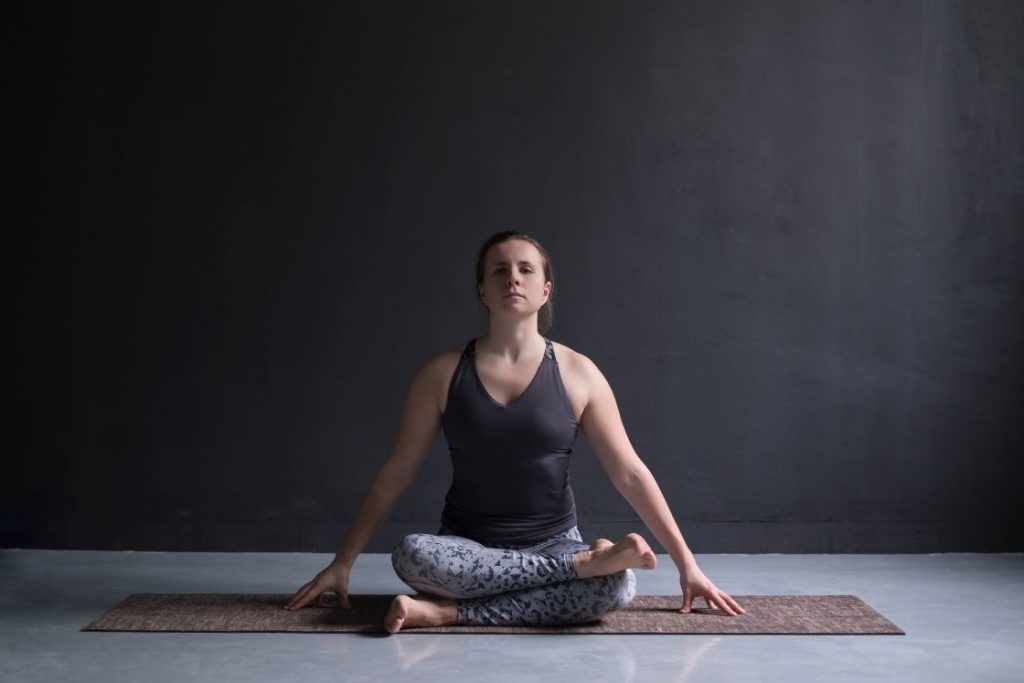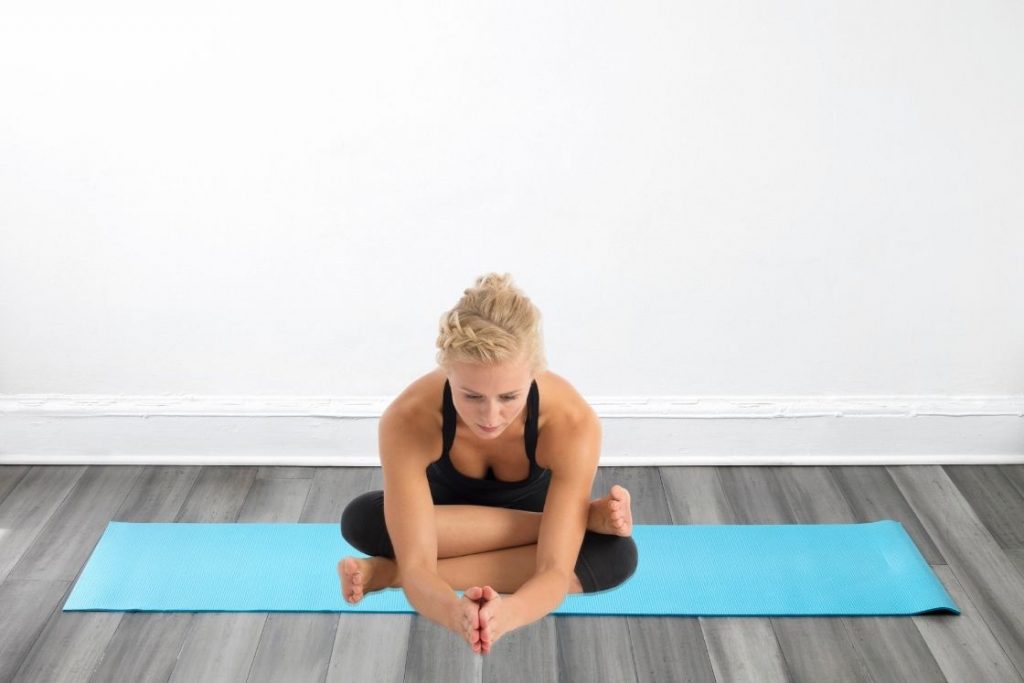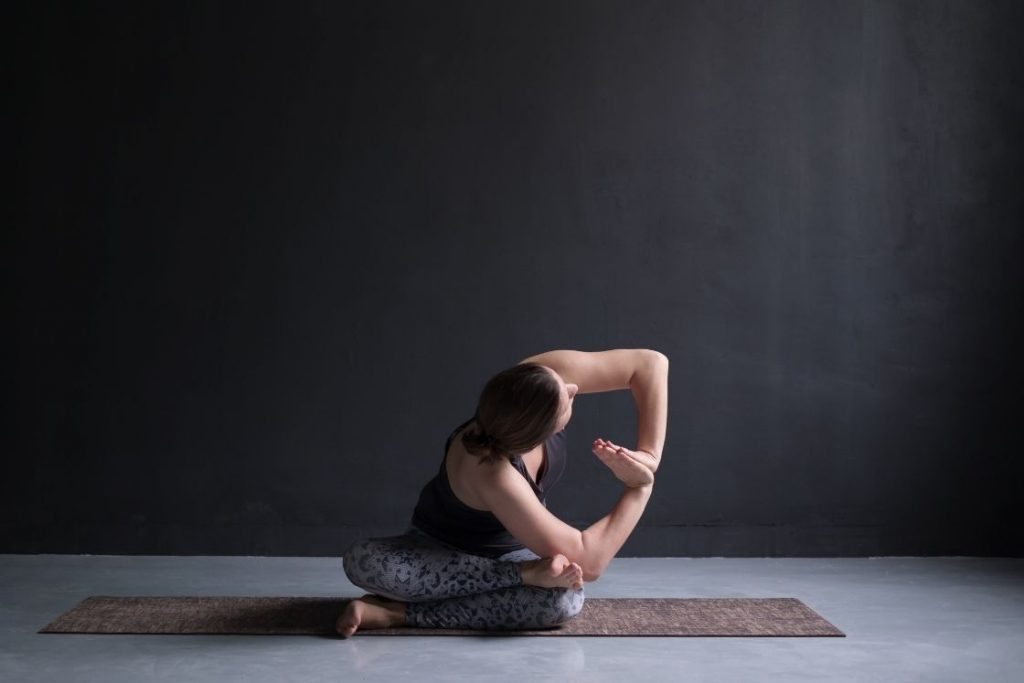
In Hindu Vedic rituals, fire (Agni) and wooden logs (stambha) are used to create a sacred space for prayers and offerings, symbolising a connection with a higher power. The Fire Log Pose in yoga carries a similar spiritual essence, along with its well-known therapeutic benefits particularly for relieving sciatic pain.
Fire Log Pose, also known as Agnistambhasana, is an advanced seated yoga posture commonly included in hip-opening sequences. It helps release deep tension in the hips and promotes flexibility in the lower body.
In this pose, the legs are stacked by placing one ankle over the opposite knee and the opposite ankle beneath the other knee resembling the shape of stacked firewood. The practitioner then folds forward from the hip joints, maintaining a long, neutral spine throughout the movement.
Meaning of agnistambhasana (Fire Log Pose)
The name Agnistambhasana comes from Sanskrit, where agni means “fire” and stambha means “log” or “pillar.” In English, this posture is commonly known as Fire Log Pose or Burning Log Pose.
In the final position of Agnistambhasana, the legs are stacked in a way that resembles two fire logs placed one over the other. Practitioners often feel an intense stretch or a burning sensation in the hips and pelvis while holding the pose further reflecting the “fire” aspect of its name.
Because the ankle-to-knee leg arrangement in this pose is similar to that in Pigeon Pose, it is also referred to as Double Pigeon Pose or Ankle-to-Knee Pose.
Fire Log Pose symbolic interpretation
Fire Log Pose is named after fire considered the purest and most transformative element in many spiritual traditions. Just as fire is used to purify gold, Agnistambhasana symbolises inner purification. Practising this pose helps release deep-seated tension from the hips and joints, promoting both physical and emotional cleansing.
Fire Log pose practice guide

Preparatory poses
- Bound Angle Pose (Baddha Konasana)
- Reclining Bound Angle Pose (Supta Baddha Konasana)
- Supine figure four
- Easy pose (Sukhasana)
How to do Fire Log pose (steps)
- Sit on the floor with your legs extended forward in Dandasana.
- Gently lift your left knee and slide the left heel toward your pelvis.
- Bend your right knee and place the right foot under the left knee.
- Keep the outer edge of your right foot parallel to the front edge of the mat.
- Place your left ankle on top of your right knee, stacking both shins like fire logs.
- Sit upright with your spine tall and your back straight.
- Bring your hands in front of your legs and place them on the floor.
- Breathe steadily and begin walking your fingertips forward, going as far as comfortable.
- Ensure you’re folding from the hip joints (groins), not bending from the waist or abdomen.
- Hold the pose for 30 to 60 seconds while maintaining a steady breath.
- Inhale and slowly walk your hands back toward the body, returning to an upright position.
- Switch leg positions and repeat the same steps on the opposite side.
- Release both legs and relax back in Dandasana.
Beginner’s tips
- If stacking one leg over the other is too challenging, you can practise a simpler variation of Agnistambhasana by sitting in Sukhasana (Easy Pose) and gradually working on hip flexibility.
- Before leaning forward, gently rotate the thighs outward from the hip joints. This external rotation helps open the hips and makes the forward bend more accessible.
Precautions & contraindications
- Take enough time to warm up the body, especially the hips, psoas, and groin area, before practising Fire Log Pose.
- Avoid rounding the back while leaning forward. Always bend from the hip joints, not from the waist.
- Do not force the knees toward the floor or push yourself into a deeper forward bend than your body allows.
- Avoid practising Agnistambhasana if you have any injury in the lower back, hips, or ankles.
- People with knee injuries or arthritis should not attempt this pose without guidance. It is generally not recommended in such conditions.
Follow-up poses
- Seated forward fold (Paschimottanasana)
- Bharadvaja’s Twist (Bharadvajasana)
Modifications
- Folded blanket – Practice agnistambasana sitting on a block if your pelvis is tilting back. This elevates the pelvis region and avoids slouching of the back.
- Blocks – Place yoga blocks between the bottom leg’s ankle and top leg’s knee. This will not exert pressure on the hips and still opens them. You can also place another block in front of your bottom shin so that the top ankle rests on it. This prevents the hurting of the ankles and stacks the shins.
Variations

- Agnistambhasana Variation 1– From dandasana bend one leg at the knee and place the respective foot on the alternate thigh. Place the hands by your side on the floor. Take 2 breaths and switch the legs to repeat the pose.
- Agnistambhasana Leaning Forward– After attaining agnistambhasana lean further by bringing your elbows to the floor. Spread your palms and bring your head to the floor.
- Agnistambhasana Variation Forward Bend– From agnistambhasana bring your elbows to the floor. Now join your palms with fingers pointing forward and set your gaze to the floor.
- Agnistambhasana Twist – Taking the left leg as the lower leg in agnistambhasana, bring your right arm behind your tailbone. Simultaneously, place your left hand beside your left foot twisting your torso.
Fire Log Pose benefits
Fire Log Pose (Agnistambhasana) is more than just a deep hip opener. It supports joint health, improves digestion, tones the lower body, and helps calm the mind. With consistent practice, it also boosts energy flow in the pelvic area and stimulates creativity.
1. Enhances flexibility
This pose deeply stretches the hips, thighs, and knees. The pressure and activation in these areas increase muscle elasticity and prevent stiffness or injury. Improved flexibility also supports better blood flow and nutrient absorption, strengthening the glutes, groin, and surrounding muscles.
2. Reduces fat
The lower body is actively engaged while holding the posture. This muscular effort helps tone the thighs and hips by burning stored fat, contributing to a leaner lower body.
3. Improves digestion
The gentle compression on the abdominal area stimulates digestive organs. This helps regulate stress hormones and boosts digestive efficiency. Regular practice can support healthy bowel movements and relieve common digestive issues.
4. Enhances sexual health
The pose activates the pelvic region and increases blood circulation to the reproductive organs. This stimulation may improve hormonal balance and support sexual vitality in both men and women.
5. Heals lower back pain
Maintaining an upright spine while sitting in Agnistambhasana strengthens the spinal muscles and improves posture. It gently stretches the lower back, helping to relieve tension and reduce chronic discomfort.
6. Benefit the nervous system
When combined with deep, steady breathing, the pose calms the mind and body. It improves oxygen supply to the brain, helping reduce stress, anxiety, and mental fatigue. It also supports better concentration and emotional balance.
7. Stimulates the sacral chakra
The pelvic opening and pranic movement in this posture help activate the Svadhisthana (sacral) chakra. This can awaken creativity, uplift mood, and enhance emotional intelligence.